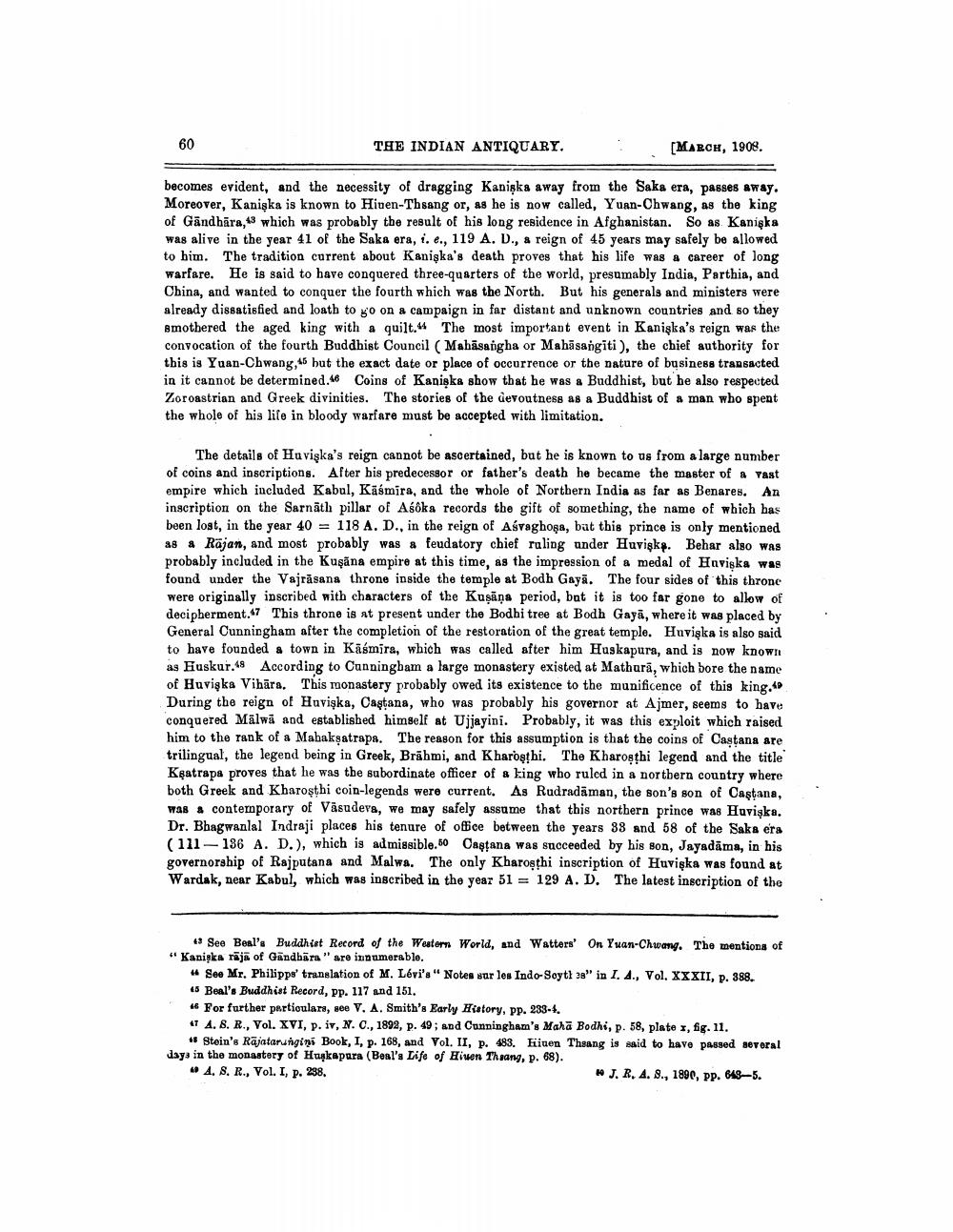________________
60
THE INDIAN ANTIQUARY.
[MARCH, 1908.
becomes evident, and the necessity of dragging Kaniska away from the Saka era, passes away. Moreover, Kaniska is known to Hiuen-Thsang or, as he is now called, Yuan-Chwang, as the king of Gāndhāra,43 which was probably the result of his long residence in Afghanistan. So as Kanişka was alive in the year 41 of the Saka era, i. e., 119 A. D., & reign of 45 years may safely be allowed to him. The tradition current about Kanişka's death proves that his life was a career of long warfare. He is said to have conquered three-quarters of the world, presumably India, Parthia, and China, and wanted to conquer the fourth which was the North. But his generals and ministers were already dissatisfied and loath to go on a campaign in far distant and unknown countries and so they smothered the aged king with a quilt. The most important event in Kaniska's reign was the convocation of the fourth Buddhist Council (Mahāsangha or Mahāsangiti), the chief authority for this is Yuan-Chwang, but the exact date or place of occurrence or the nature of business transacted in it cannot be determined.46 Coins of Kaniska show that he was a Buddhist, but he also respected Zoroastrian and Greek divinities. The stories of the devoutness as a Buddhist of a man who spent the whole of his life in bloody warfare must be accepted with limitation.
The details of Hu viska's reign cannot be ascertained, but he is known to us from a large number of coins and inscriptions. After his predecessor or father's death he became the master of a vast empire which included Kabul, Käsmīra, and the whole of Northern India as far as Benares. An inscription on the Sarnāth pillar of Asoka records the gift of something, the name of which has been lost, in the year 40 = 118 A.D., in the reign of Asvaghoşa, bat this prince is only mentioned as a Rājan, and most probably was a feudatory chief raling under Huvisk. Behar also was probably included in the Kuşāna empire at this time, as the impression of a medal of Hovigka was found under the Vajrāsana throne inside the temple at Bodh Gaya. The four sides of this throne were originally inscribed with characters of the Kuşāņa period, but it is too far gone to allow of decipherment. This throne is at present under the Bodhi tree at Bodh Gayā, where it was placed by General Cunningham after the completion of the restoration of the great temple. Huviska is also said to have founded a town in Kāśmira, which was called after him Huskapura, and is now known as Fiuskur. According to Canningbam a large monastery existed at Mathurā, which bore the name of Huvişka Vibāra. This monastery probably owed its existence to the munificence of this king. During the reign of Havişka, Caştana, who was probably his governor at Ajmer, seems to have conquered Mälwa and established himself at Ujjayini. Probably, it was this exploit which raised him to the rank of a Mabakşatraps. The reason for this assumption is that the coins of Castana are trilingual, the legend being in Greek, Brāhmi, and Kharoshi. The Kharoşthi legend and the title Kaatrapa proves that he was the subordinate officer of a king who ruled in a northern country where both Greek and Kharoşthi coin-legends were current. As Rudradāman, the son's son of Castana, was a contemporary of Väsudeva, we may safely assume that this northern prince was Havişka. Dr. Bhagwanlal Indraji places his tenure of office between the years 88 and 58 of the Saka era (111-136 A. D.), which is admissible.60 Caetana was succeeded by his son, Jayadāma, in his governorship of Rajputana and Malwa. The only Kharoşthi inscription of Huviska was found at Wardak, near Kabul, which was inscribed in the year 51 = 129 A.D. The latest inscription of the
13 See Beal's Buddhist Record of the Western World, and Watters' On Yuan-Chwang. The mentiona of "Kaniska rājā of Gandbāra " are innumerable.
* See Mr. Philippo' translation of M. Lévi's" Notes sur les Indo-Soyti 38" in I. A., Vol. XXXII, p. 388. t5 Beal's Buddhist Record, pp. 117 and 151. 46 For further particulars, see V, A. Smith's Early History, pp. 283-4. 41 A, . R., Vol. XVI, p. iv, N. O., 1892, p. 49; and Cunningham's Maha Bodhi, p. 58, plate y, fig. 11.
18 Stein's Rājatarungini Book, I, p. 168, and Vol. II, p. 483. Tiiuen Thsang is said to have passed several days in the monastery of Hugkapura (Beal's Life of Hiven Th sang, p. 68). ** A, S. R., Vol. I, p. 238.
49 J. R. A. 8., 1890, PP. 648-5.




